Operations Management Literature Review
VerifiedAdded on 2020/06/06
|15
|4110
|29
AI Summary
This assignment requires a detailed literature review on the topic of Operations Management. The review should cover key areas within operations management such as supply chain management, sustainability in operations, and the role of human resources. It necessitates analyzing existing research papers and synthesizing insights from various studies to present a comprehensive understanding of current trends and challenges in the field.
Contribute Materials
Your contribution can guide someone’s learning journey. Share your
documents today.
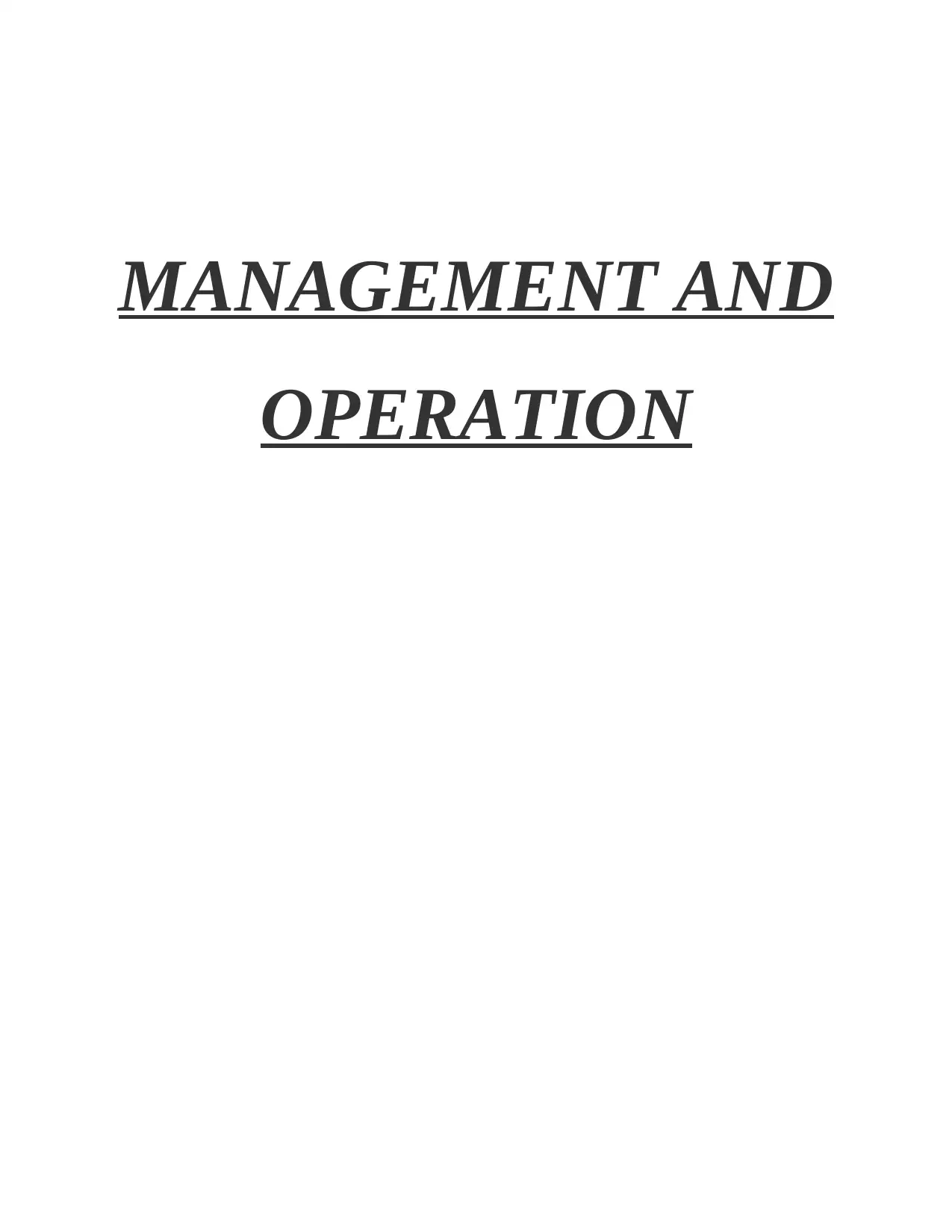
MANAGEMENT AND
OPERATION
OPERATION
Secure Best Marks with AI Grader
Need help grading? Try our AI Grader for instant feedback on your assignments.
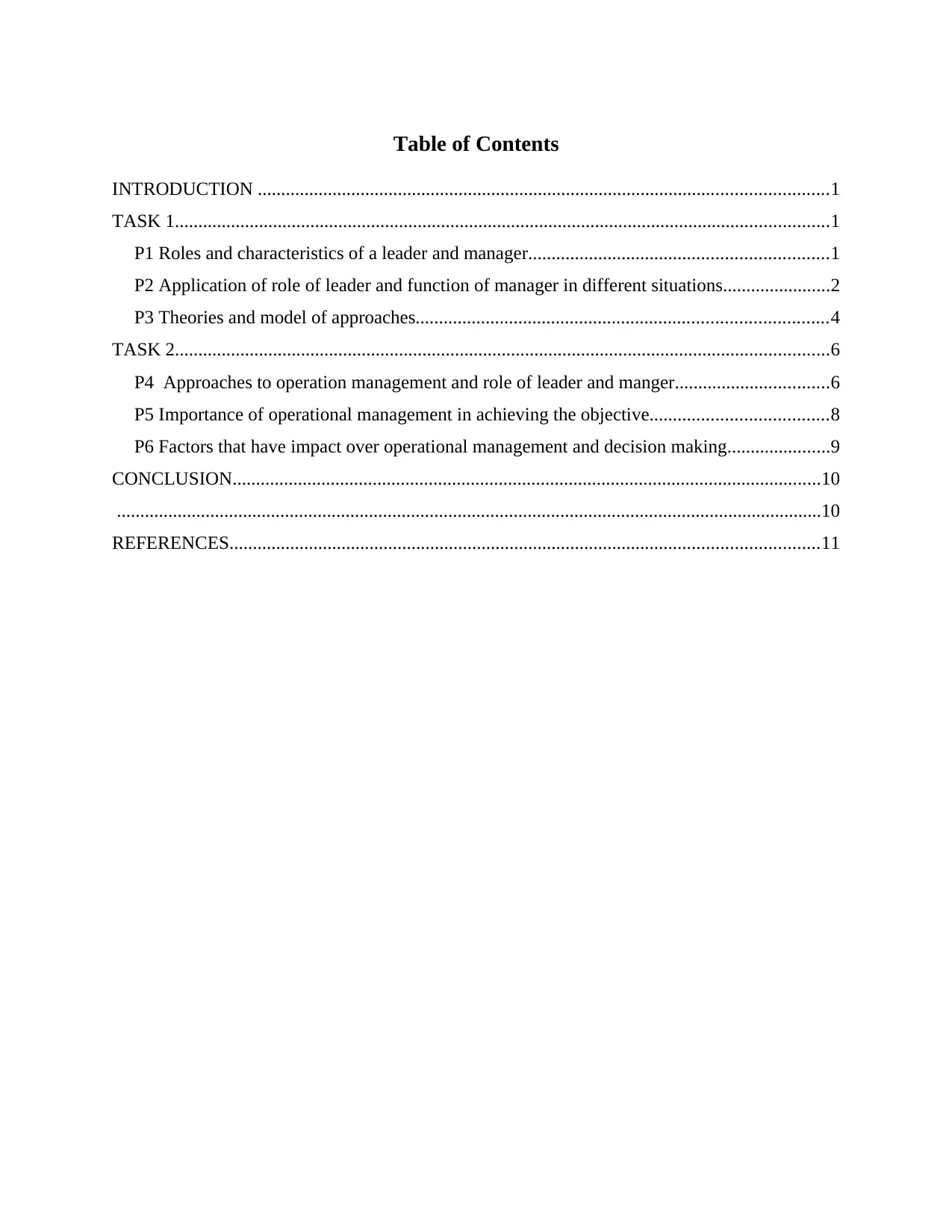
Table of Contents
INTRODUCTION ..........................................................................................................................1
TASK 1............................................................................................................................................1
P1 Roles and characteristics of a leader and manager................................................................1
P2 Application of role of leader and function of manager in different situations.......................2
P3 Theories and model of approaches........................................................................................4
TASK 2............................................................................................................................................6
P4 Approaches to operation management and role of leader and manger.................................6
P5 Importance of operational management in achieving the objective......................................8
P6 Factors that have impact over operational management and decision making......................9
CONCLUSION..............................................................................................................................10
.......................................................................................................................................................10
REFERENCES..............................................................................................................................11
INTRODUCTION ..........................................................................................................................1
TASK 1............................................................................................................................................1
P1 Roles and characteristics of a leader and manager................................................................1
P2 Application of role of leader and function of manager in different situations.......................2
P3 Theories and model of approaches........................................................................................4
TASK 2............................................................................................................................................6
P4 Approaches to operation management and role of leader and manger.................................6
P5 Importance of operational management in achieving the objective......................................8
P6 Factors that have impact over operational management and decision making......................9
CONCLUSION..............................................................................................................................10
.......................................................................................................................................................10
REFERENCES..............................................................................................................................11

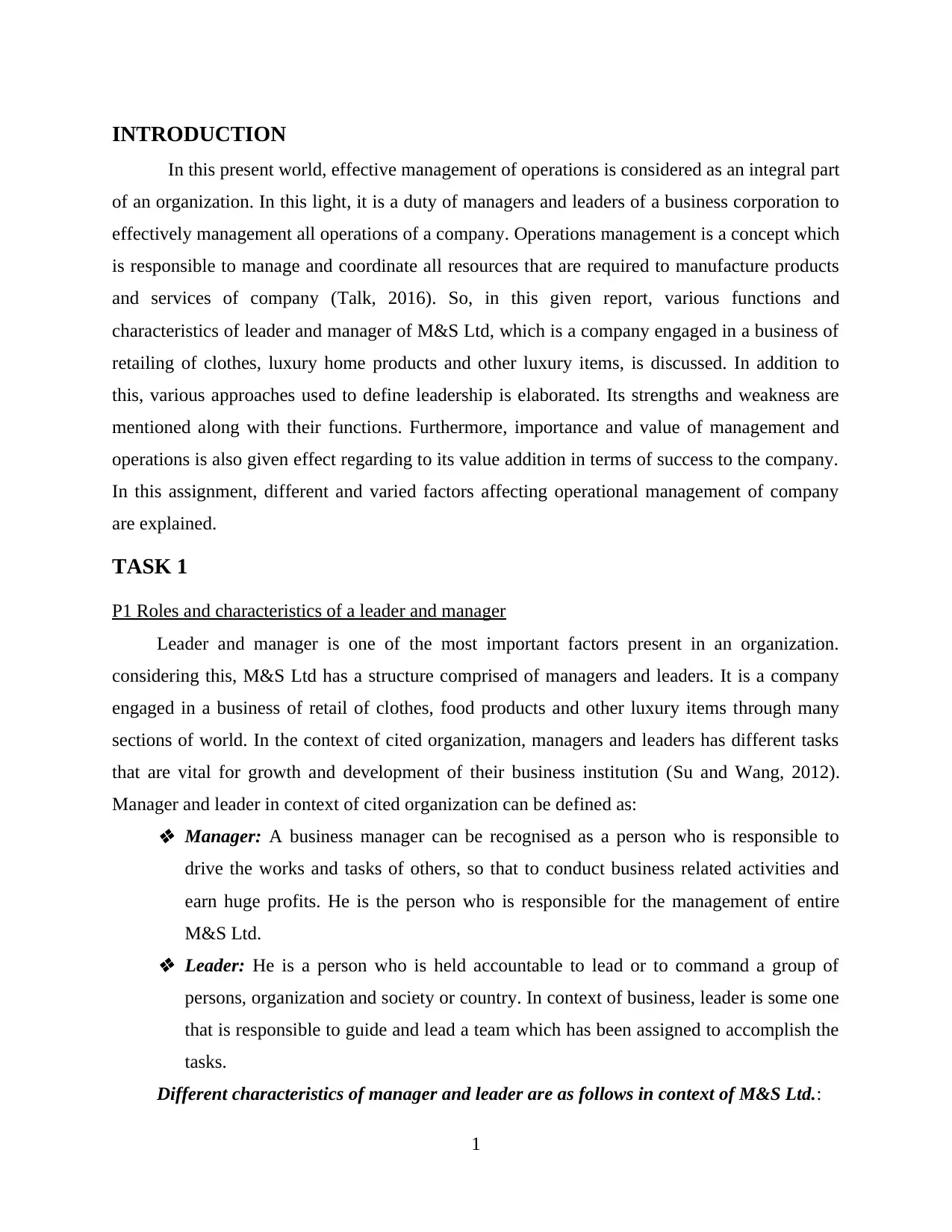
INTRODUCTION
In this present world, effective management of operations is considered as an integral part
of an organization. In this light, it is a duty of managers and leaders of a business corporation to
effectively management all operations of a company. Operations management is a concept which
is responsible to manage and coordinate all resources that are required to manufacture products
and services of company (Talk, 2016). So, in this given report, various functions and
characteristics of leader and manager of M&S Ltd, which is a company engaged in a business of
retailing of clothes, luxury home products and other luxury items, is discussed. In addition to
this, various approaches used to define leadership is elaborated. Its strengths and weakness are
mentioned along with their functions. Furthermore, importance and value of management and
operations is also given effect regarding to its value addition in terms of success to the company.
In this assignment, different and varied factors affecting operational management of company
are explained.
TASK 1
P1 Roles and characteristics of a leader and manager
Leader and manager is one of the most important factors present in an organization.
considering this, M&S Ltd has a structure comprised of managers and leaders. It is a company
engaged in a business of retail of clothes, food products and other luxury items through many
sections of world. In the context of cited organization, managers and leaders has different tasks
that are vital for growth and development of their business institution (Su and Wang, 2012).
Manager and leader in context of cited organization can be defined as:
Manager: A business manager can be recognised as a person who is responsible to
drive the works and tasks of others, so that to conduct business related activities and
earn huge profits. He is the person who is responsible for the management of entire
M&S Ltd.
Leader: He is a person who is held accountable to lead or to command a group of
persons, organization and society or country. In context of business, leader is some one
that is responsible to guide and lead a team which has been assigned to accomplish the
tasks.
Different characteristics of manager and leader are as follows in context of M&S Ltd.:
1
In this present world, effective management of operations is considered as an integral part
of an organization. In this light, it is a duty of managers and leaders of a business corporation to
effectively management all operations of a company. Operations management is a concept which
is responsible to manage and coordinate all resources that are required to manufacture products
and services of company (Talk, 2016). So, in this given report, various functions and
characteristics of leader and manager of M&S Ltd, which is a company engaged in a business of
retailing of clothes, luxury home products and other luxury items, is discussed. In addition to
this, various approaches used to define leadership is elaborated. Its strengths and weakness are
mentioned along with their functions. Furthermore, importance and value of management and
operations is also given effect regarding to its value addition in terms of success to the company.
In this assignment, different and varied factors affecting operational management of company
are explained.
TASK 1
P1 Roles and characteristics of a leader and manager
Leader and manager is one of the most important factors present in an organization.
considering this, M&S Ltd has a structure comprised of managers and leaders. It is a company
engaged in a business of retail of clothes, food products and other luxury items through many
sections of world. In the context of cited organization, managers and leaders has different tasks
that are vital for growth and development of their business institution (Su and Wang, 2012).
Manager and leader in context of cited organization can be defined as:
Manager: A business manager can be recognised as a person who is responsible to
drive the works and tasks of others, so that to conduct business related activities and
earn huge profits. He is the person who is responsible for the management of entire
M&S Ltd.
Leader: He is a person who is held accountable to lead or to command a group of
persons, organization and society or country. In context of business, leader is some one
that is responsible to guide and lead a team which has been assigned to accomplish the
tasks.
Different characteristics of manager and leader are as follows in context of M&S Ltd.:
1
Secure Best Marks with AI Grader
Need help grading? Try our AI Grader for instant feedback on your assignments.
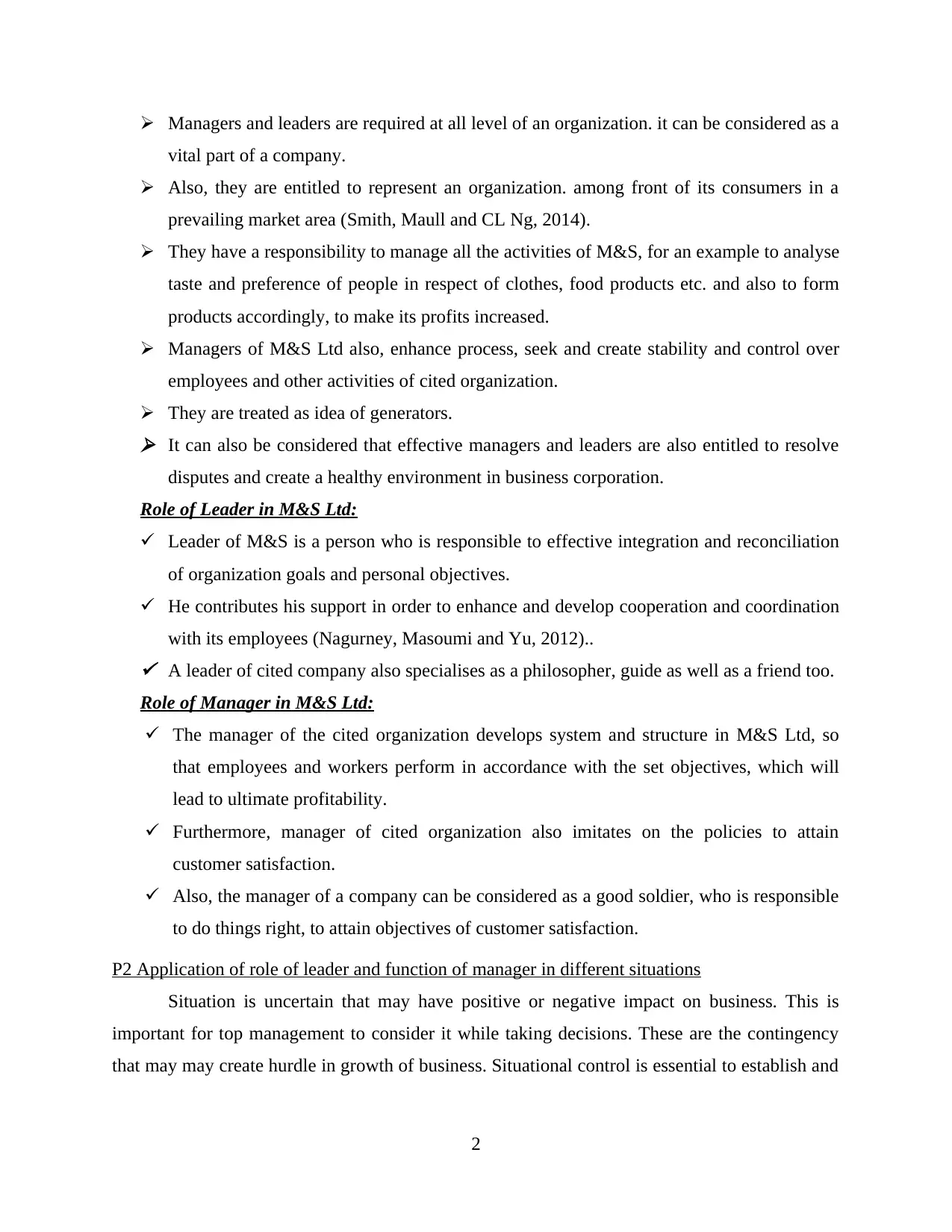
Managers and leaders are required at all level of an organization. it can be considered as a
vital part of a company.
Also, they are entitled to represent an organization. among front of its consumers in a
prevailing market area (Smith, Maull and CL Ng, 2014).
They have a responsibility to manage all the activities of M&S, for an example to analyse
taste and preference of people in respect of clothes, food products etc. and also to form
products accordingly, to make its profits increased.
Managers of M&S Ltd also, enhance process, seek and create stability and control over
employees and other activities of cited organization.
They are treated as idea of generators. It can also be considered that effective managers and leaders are also entitled to resolve
disputes and create a healthy environment in business corporation.
Role of Leader in M&S Ltd:
Leader of M&S is a person who is responsible to effective integration and reconciliation
of organization goals and personal objectives.
He contributes his support in order to enhance and develop cooperation and coordination
with its employees (Nagurney, Masoumi and Yu, 2012).. A leader of cited company also specialises as a philosopher, guide as well as a friend too.
Role of Manager in M&S Ltd:
The manager of the cited organization develops system and structure in M&S Ltd, so
that employees and workers perform in accordance with the set objectives, which will
lead to ultimate profitability.
Furthermore, manager of cited organization also imitates on the policies to attain
customer satisfaction.
Also, the manager of a company can be considered as a good soldier, who is responsible
to do things right, to attain objectives of customer satisfaction.
P2 Application of role of leader and function of manager in different situations
Situation is uncertain that may have positive or negative impact on business. This is
important for top management to consider it while taking decisions. These are the contingency
that may may create hurdle in growth of business. Situational control is essential to establish and
2
vital part of a company.
Also, they are entitled to represent an organization. among front of its consumers in a
prevailing market area (Smith, Maull and CL Ng, 2014).
They have a responsibility to manage all the activities of M&S, for an example to analyse
taste and preference of people in respect of clothes, food products etc. and also to form
products accordingly, to make its profits increased.
Managers of M&S Ltd also, enhance process, seek and create stability and control over
employees and other activities of cited organization.
They are treated as idea of generators. It can also be considered that effective managers and leaders are also entitled to resolve
disputes and create a healthy environment in business corporation.
Role of Leader in M&S Ltd:
Leader of M&S is a person who is responsible to effective integration and reconciliation
of organization goals and personal objectives.
He contributes his support in order to enhance and develop cooperation and coordination
with its employees (Nagurney, Masoumi and Yu, 2012).. A leader of cited company also specialises as a philosopher, guide as well as a friend too.
Role of Manager in M&S Ltd:
The manager of the cited organization develops system and structure in M&S Ltd, so
that employees and workers perform in accordance with the set objectives, which will
lead to ultimate profitability.
Furthermore, manager of cited organization also imitates on the policies to attain
customer satisfaction.
Also, the manager of a company can be considered as a good soldier, who is responsible
to do things right, to attain objectives of customer satisfaction.
P2 Application of role of leader and function of manager in different situations
Situation is uncertain that may have positive or negative impact on business. This is
important for top management to consider it while taking decisions. These are the contingency
that may may create hurdle in growth of business. Situational control is essential to establish and
2
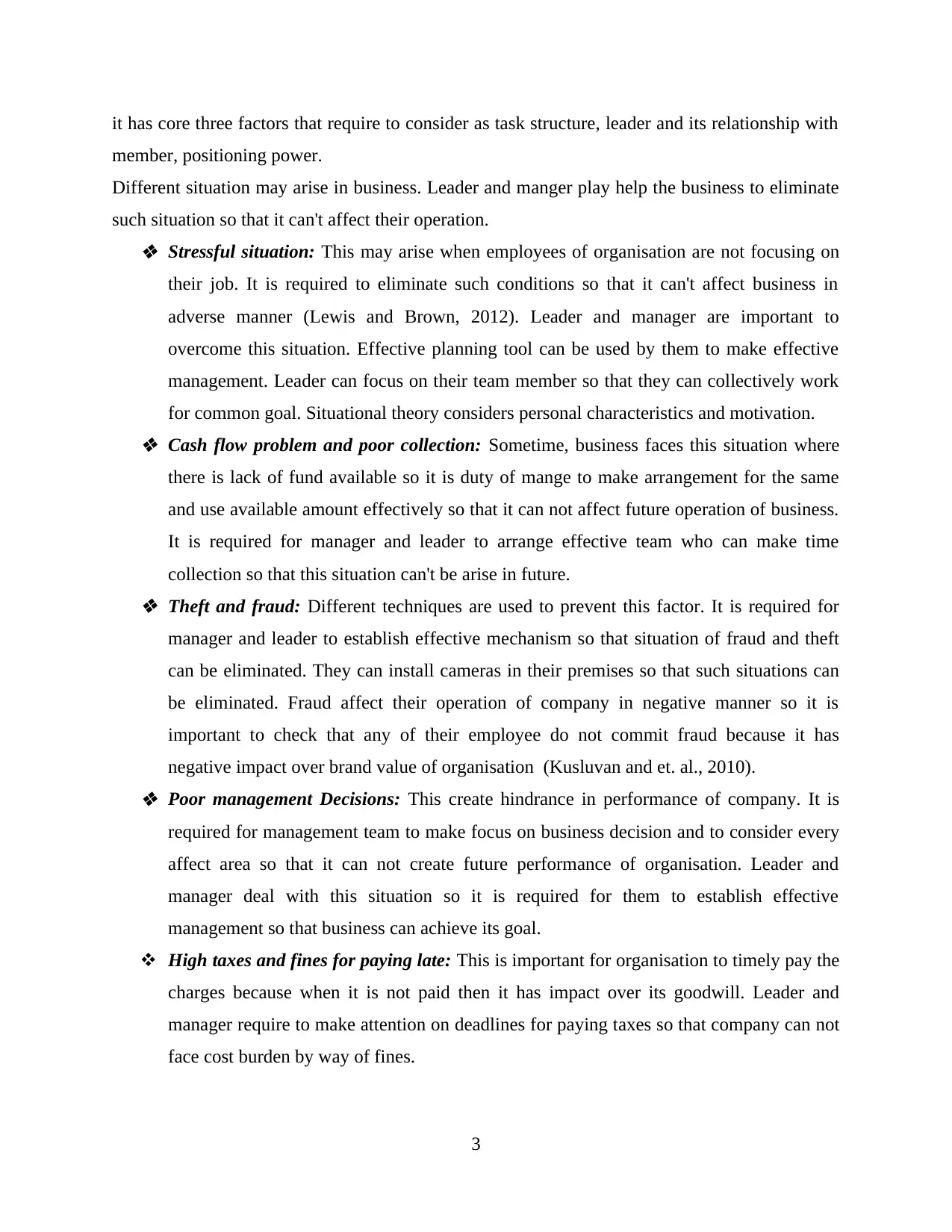
it has core three factors that require to consider as task structure, leader and its relationship with
member, positioning power.
Different situation may arise in business. Leader and manger play help the business to eliminate
such situation so that it can't affect their operation. Stressful situation: This may arise when employees of organisation are not focusing on
their job. It is required to eliminate such conditions so that it can't affect business in
adverse manner (Lewis and Brown, 2012). Leader and manager are important to
overcome this situation. Effective planning tool can be used by them to make effective
management. Leader can focus on their team member so that they can collectively work
for common goal. Situational theory considers personal characteristics and motivation. Cash flow problem and poor collection: Sometime, business faces this situation where
there is lack of fund available so it is duty of mange to make arrangement for the same
and use available amount effectively so that it can not affect future operation of business.
It is required for manager and leader to arrange effective team who can make time
collection so that this situation can't be arise in future. Theft and fraud: Different techniques are used to prevent this factor. It is required for
manager and leader to establish effective mechanism so that situation of fraud and theft
can be eliminated. They can install cameras in their premises so that such situations can
be eliminated. Fraud affect their operation of company in negative manner so it is
important to check that any of their employee do not commit fraud because it has
negative impact over brand value of organisation (Kusluvan and et. al., 2010). Poor management Decisions: This create hindrance in performance of company. It is
required for management team to make focus on business decision and to consider every
affect area so that it can not create future performance of organisation. Leader and
manager deal with this situation so it is required for them to establish effective
management so that business can achieve its goal.
High taxes and fines for paying late: This is important for organisation to timely pay the
charges because when it is not paid then it has impact over its goodwill. Leader and
manager require to make attention on deadlines for paying taxes so that company can not
face cost burden by way of fines.
3
member, positioning power.
Different situation may arise in business. Leader and manger play help the business to eliminate
such situation so that it can't affect their operation. Stressful situation: This may arise when employees of organisation are not focusing on
their job. It is required to eliminate such conditions so that it can't affect business in
adverse manner (Lewis and Brown, 2012). Leader and manager are important to
overcome this situation. Effective planning tool can be used by them to make effective
management. Leader can focus on their team member so that they can collectively work
for common goal. Situational theory considers personal characteristics and motivation. Cash flow problem and poor collection: Sometime, business faces this situation where
there is lack of fund available so it is duty of mange to make arrangement for the same
and use available amount effectively so that it can not affect future operation of business.
It is required for manager and leader to arrange effective team who can make time
collection so that this situation can't be arise in future. Theft and fraud: Different techniques are used to prevent this factor. It is required for
manager and leader to establish effective mechanism so that situation of fraud and theft
can be eliminated. They can install cameras in their premises so that such situations can
be eliminated. Fraud affect their operation of company in negative manner so it is
important to check that any of their employee do not commit fraud because it has
negative impact over brand value of organisation (Kusluvan and et. al., 2010). Poor management Decisions: This create hindrance in performance of company. It is
required for management team to make focus on business decision and to consider every
affect area so that it can not create future performance of organisation. Leader and
manager deal with this situation so it is required for them to establish effective
management so that business can achieve its goal.
High taxes and fines for paying late: This is important for organisation to timely pay the
charges because when it is not paid then it has impact over its goodwill. Leader and
manager require to make attention on deadlines for paying taxes so that company can not
face cost burden by way of fines.
3
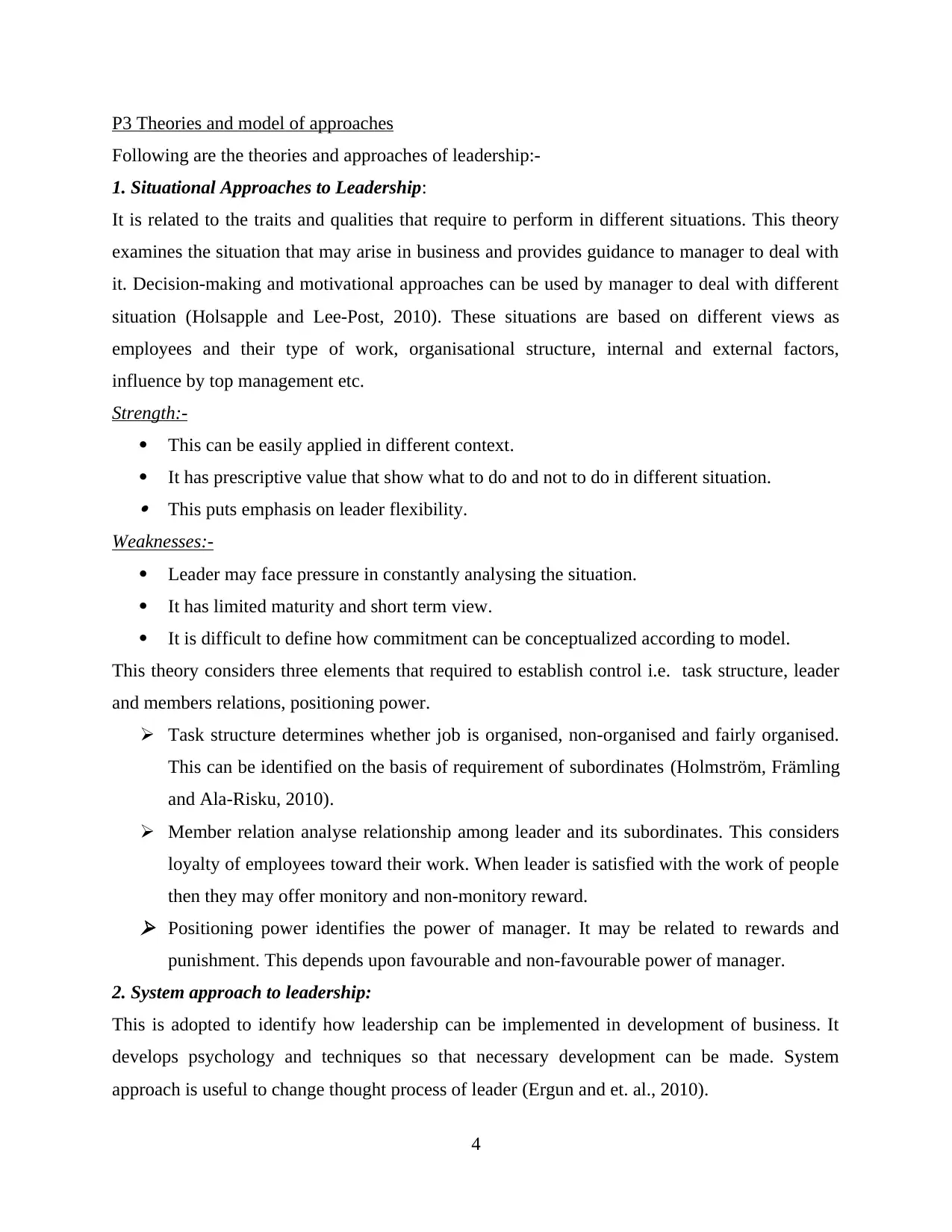
P3 Theories and model of approaches
Following are the theories and approaches of leadership:-
1. Situational Approaches to Leadership:
It is related to the traits and qualities that require to perform in different situations. This theory
examines the situation that may arise in business and provides guidance to manager to deal with
it. Decision-making and motivational approaches can be used by manager to deal with different
situation (Holsapple and Lee-Post, 2010). These situations are based on different views as
employees and their type of work, organisational structure, internal and external factors,
influence by top management etc.
Strength:-
This can be easily applied in different context.
It has prescriptive value that show what to do and not to do in different situation. This puts emphasis on leader flexibility.
Weaknesses:-
Leader may face pressure in constantly analysing the situation.
It has limited maturity and short term view.
It is difficult to define how commitment can be conceptualized according to model.
This theory considers three elements that required to establish control i.e. task structure, leader
and members relations, positioning power.
Task structure determines whether job is organised, non-organised and fairly organised.
This can be identified on the basis of requirement of subordinates (Holmström, Främling
and Ala-Risku, 2010).
Member relation analyse relationship among leader and its subordinates. This considers
loyalty of employees toward their work. When leader is satisfied with the work of people
then they may offer monitory and non-monitory reward. Positioning power identifies the power of manager. It may be related to rewards and
punishment. This depends upon favourable and non-favourable power of manager.
2. System approach to leadership:
This is adopted to identify how leadership can be implemented in development of business. It
develops psychology and techniques so that necessary development can be made. System
approach is useful to change thought process of leader (Ergun and et. al., 2010).
4
Following are the theories and approaches of leadership:-
1. Situational Approaches to Leadership:
It is related to the traits and qualities that require to perform in different situations. This theory
examines the situation that may arise in business and provides guidance to manager to deal with
it. Decision-making and motivational approaches can be used by manager to deal with different
situation (Holsapple and Lee-Post, 2010). These situations are based on different views as
employees and their type of work, organisational structure, internal and external factors,
influence by top management etc.
Strength:-
This can be easily applied in different context.
It has prescriptive value that show what to do and not to do in different situation. This puts emphasis on leader flexibility.
Weaknesses:-
Leader may face pressure in constantly analysing the situation.
It has limited maturity and short term view.
It is difficult to define how commitment can be conceptualized according to model.
This theory considers three elements that required to establish control i.e. task structure, leader
and members relations, positioning power.
Task structure determines whether job is organised, non-organised and fairly organised.
This can be identified on the basis of requirement of subordinates (Holmström, Främling
and Ala-Risku, 2010).
Member relation analyse relationship among leader and its subordinates. This considers
loyalty of employees toward their work. When leader is satisfied with the work of people
then they may offer monitory and non-monitory reward. Positioning power identifies the power of manager. It may be related to rewards and
punishment. This depends upon favourable and non-favourable power of manager.
2. System approach to leadership:
This is adopted to identify how leadership can be implemented in development of business. It
develops psychology and techniques so that necessary development can be made. System
approach is useful to change thought process of leader (Ergun and et. al., 2010).
4
Paraphrase This Document
Need a fresh take? Get an instant paraphrase of this document with our AI Paraphraser
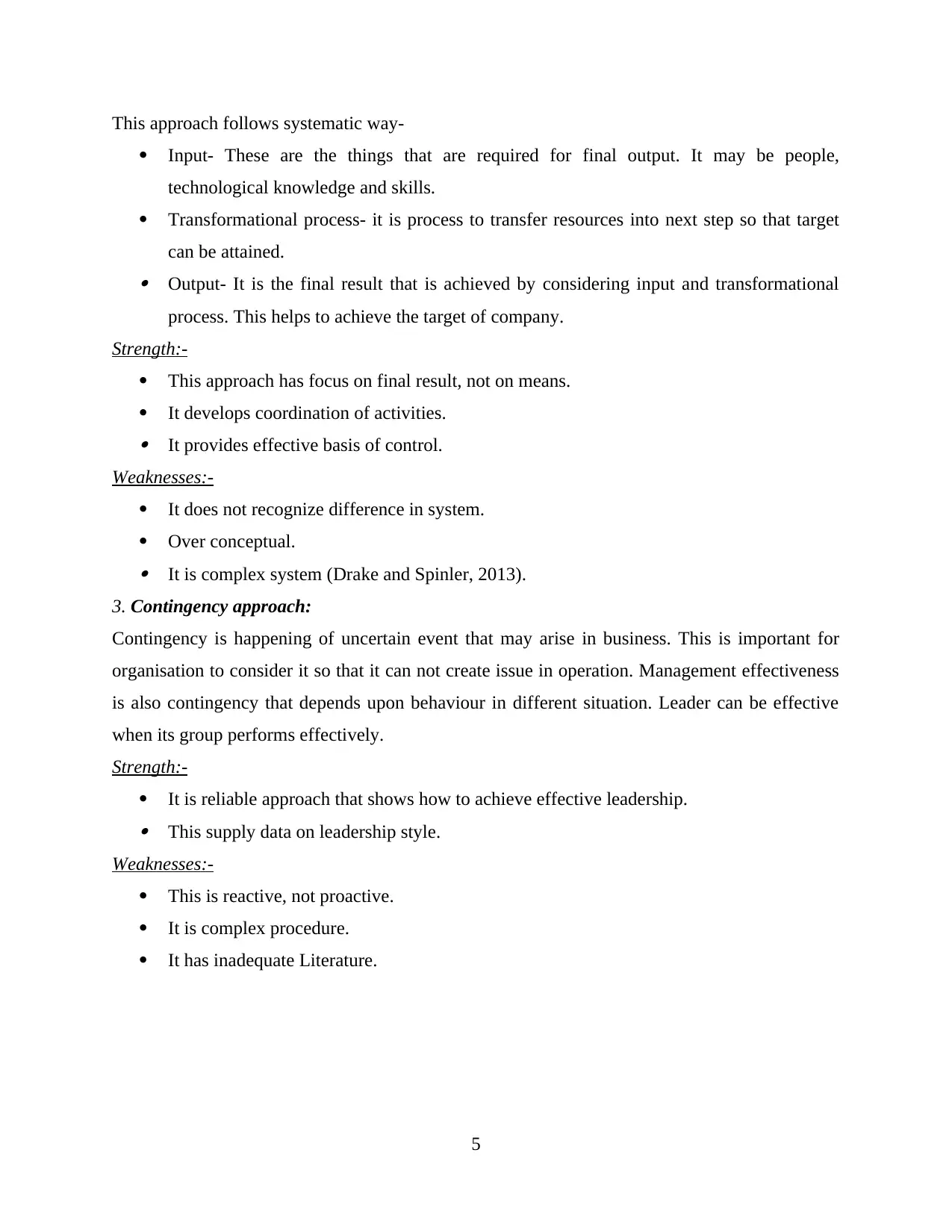
This approach follows systematic way-
Input- These are the things that are required for final output. It may be people,
technological knowledge and skills.
Transformational process- it is process to transfer resources into next step so that target
can be attained. Output- It is the final result that is achieved by considering input and transformational
process. This helps to achieve the target of company.
Strength:-
This approach has focus on final result, not on means.
It develops coordination of activities. It provides effective basis of control.
Weaknesses:-
It does not recognize difference in system.
Over conceptual. It is complex system (Drake and Spinler, 2013).
3. Contingency approach:
Contingency is happening of uncertain event that may arise in business. This is important for
organisation to consider it so that it can not create issue in operation. Management effectiveness
is also contingency that depends upon behaviour in different situation. Leader can be effective
when its group performs effectively.
Strength:-
It is reliable approach that shows how to achieve effective leadership. This supply data on leadership style.
Weaknesses:-
This is reactive, not proactive.
It is complex procedure.
It has inadequate Literature.
5
Input- These are the things that are required for final output. It may be people,
technological knowledge and skills.
Transformational process- it is process to transfer resources into next step so that target
can be attained. Output- It is the final result that is achieved by considering input and transformational
process. This helps to achieve the target of company.
Strength:-
This approach has focus on final result, not on means.
It develops coordination of activities. It provides effective basis of control.
Weaknesses:-
It does not recognize difference in system.
Over conceptual. It is complex system (Drake and Spinler, 2013).
3. Contingency approach:
Contingency is happening of uncertain event that may arise in business. This is important for
organisation to consider it so that it can not create issue in operation. Management effectiveness
is also contingency that depends upon behaviour in different situation. Leader can be effective
when its group performs effectively.
Strength:-
It is reliable approach that shows how to achieve effective leadership. This supply data on leadership style.
Weaknesses:-
This is reactive, not proactive.
It is complex procedure.
It has inadequate Literature.
5
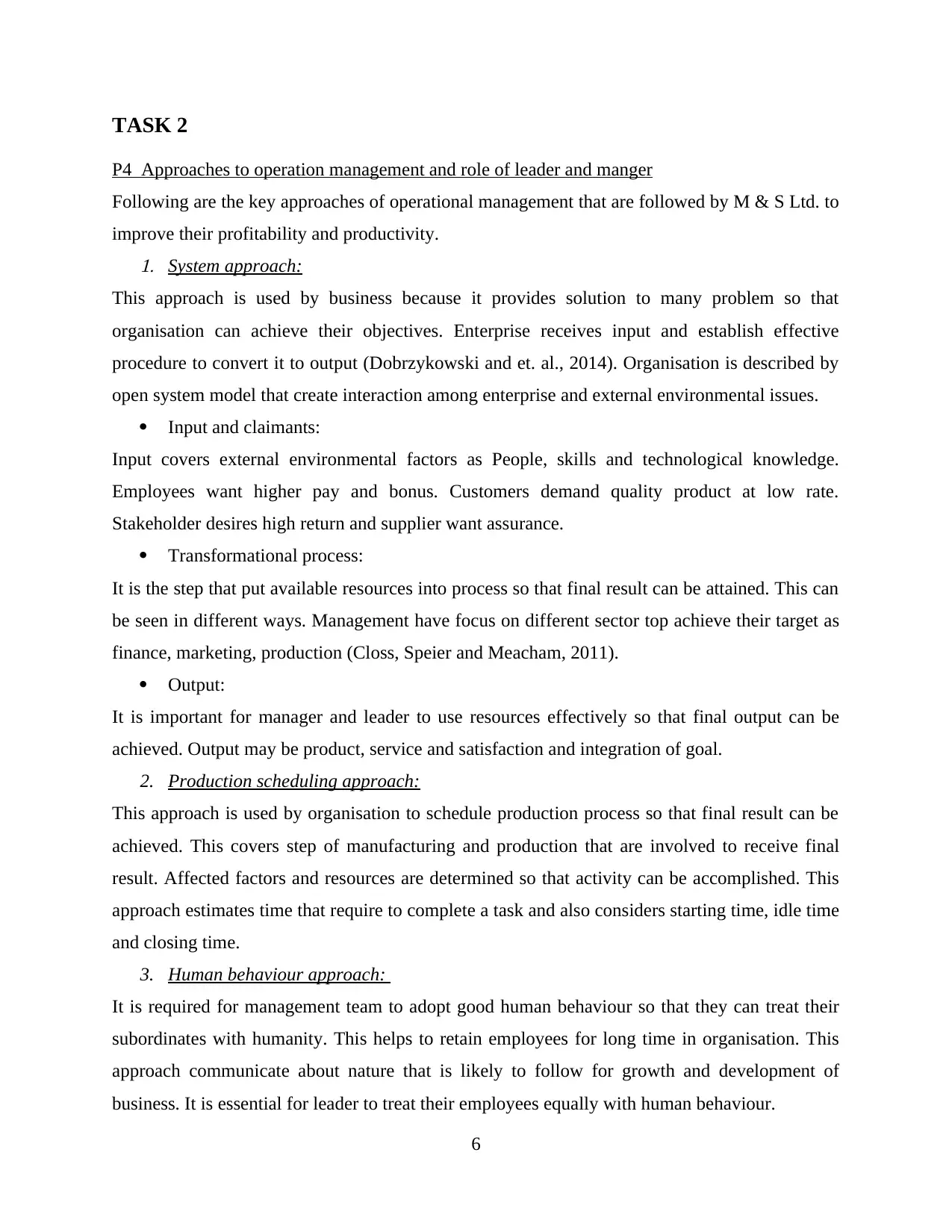
TASK 2
P4 Approaches to operation management and role of leader and manger
Following are the key approaches of operational management that are followed by M & S Ltd. to
improve their profitability and productivity.1. System approach:
This approach is used by business because it provides solution to many problem so that
organisation can achieve their objectives. Enterprise receives input and establish effective
procedure to convert it to output (Dobrzykowski and et. al., 2014). Organisation is described by
open system model that create interaction among enterprise and external environmental issues.
Input and claimants:
Input covers external environmental factors as People, skills and technological knowledge.
Employees want higher pay and bonus. Customers demand quality product at low rate.
Stakeholder desires high return and supplier want assurance.
Transformational process:
It is the step that put available resources into process so that final result can be attained. This can
be seen in different ways. Management have focus on different sector top achieve their target as
finance, marketing, production (Closs, Speier and Meacham, 2011).
Output:
It is important for manager and leader to use resources effectively so that final output can be
achieved. Output may be product, service and satisfaction and integration of goal.
2. Production scheduling approach:
This approach is used by organisation to schedule production process so that final result can be
achieved. This covers step of manufacturing and production that are involved to receive final
result. Affected factors and resources are determined so that activity can be accomplished. This
approach estimates time that require to complete a task and also considers starting time, idle time
and closing time.
3. Human behaviour approach:
It is required for management team to adopt good human behaviour so that they can treat their
subordinates with humanity. This helps to retain employees for long time in organisation. This
approach communicate about nature that is likely to follow for growth and development of
business. It is essential for leader to treat their employees equally with human behaviour.
6
P4 Approaches to operation management and role of leader and manger
Following are the key approaches of operational management that are followed by M & S Ltd. to
improve their profitability and productivity.1. System approach:
This approach is used by business because it provides solution to many problem so that
organisation can achieve their objectives. Enterprise receives input and establish effective
procedure to convert it to output (Dobrzykowski and et. al., 2014). Organisation is described by
open system model that create interaction among enterprise and external environmental issues.
Input and claimants:
Input covers external environmental factors as People, skills and technological knowledge.
Employees want higher pay and bonus. Customers demand quality product at low rate.
Stakeholder desires high return and supplier want assurance.
Transformational process:
It is the step that put available resources into process so that final result can be attained. This can
be seen in different ways. Management have focus on different sector top achieve their target as
finance, marketing, production (Closs, Speier and Meacham, 2011).
Output:
It is important for manager and leader to use resources effectively so that final output can be
achieved. Output may be product, service and satisfaction and integration of goal.
2. Production scheduling approach:
This approach is used by organisation to schedule production process so that final result can be
achieved. This covers step of manufacturing and production that are involved to receive final
result. Affected factors and resources are determined so that activity can be accomplished. This
approach estimates time that require to complete a task and also considers starting time, idle time
and closing time.
3. Human behaviour approach:
It is required for management team to adopt good human behaviour so that they can treat their
subordinates with humanity. This helps to retain employees for long time in organisation. This
approach communicate about nature that is likely to follow for growth and development of
business. It is essential for leader to treat their employees equally with human behaviour.
6
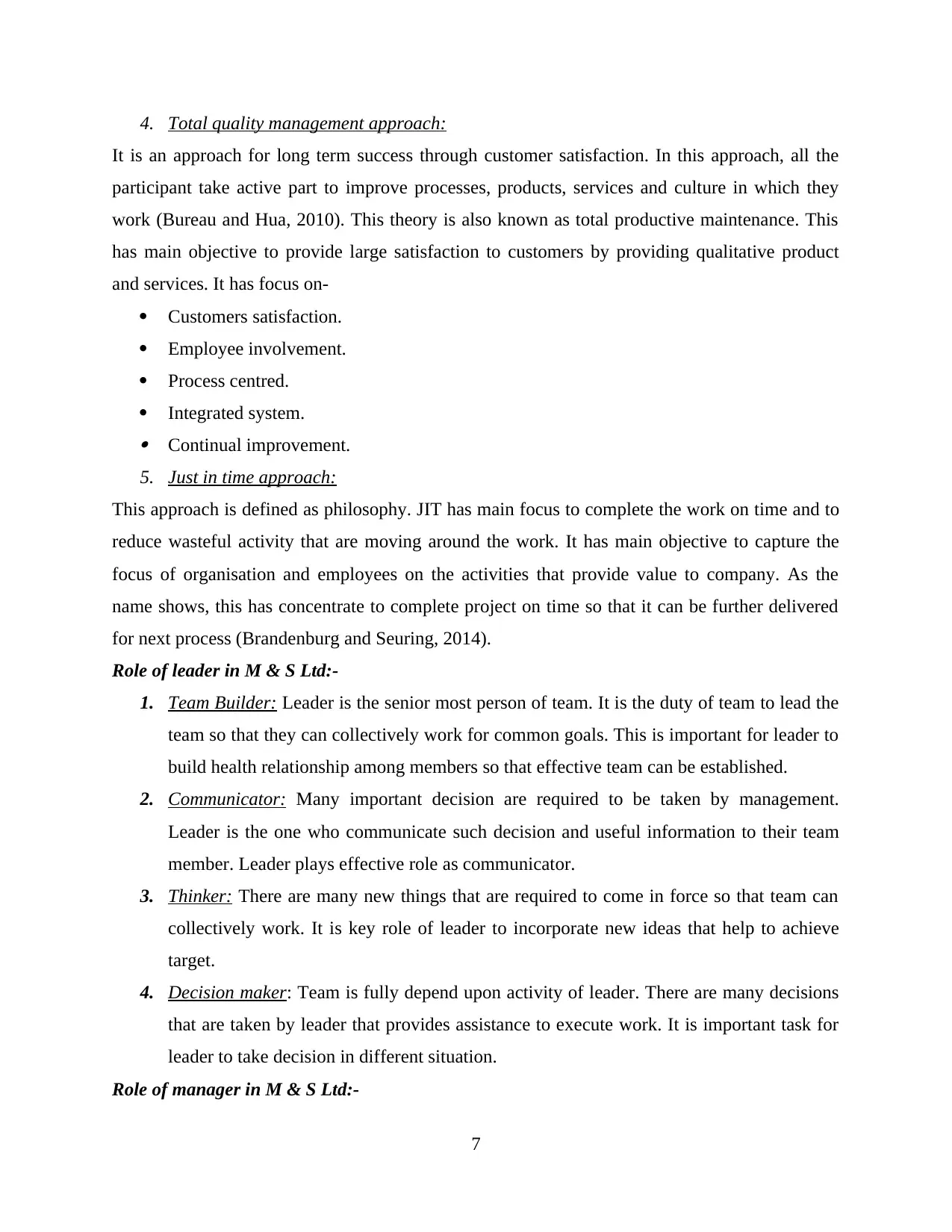
4. Total quality management approach:
It is an approach for long term success through customer satisfaction. In this approach, all the
participant take active part to improve processes, products, services and culture in which they
work (Bureau and Hua, 2010). This theory is also known as total productive maintenance. This
has main objective to provide large satisfaction to customers by providing qualitative product
and services. It has focus on-
Customers satisfaction.
Employee involvement.
Process centred.
Integrated system. Continual improvement.
5. Just in time approach:
This approach is defined as philosophy. JIT has main focus to complete the work on time and to
reduce wasteful activity that are moving around the work. It has main objective to capture the
focus of organisation and employees on the activities that provide value to company. As the
name shows, this has concentrate to complete project on time so that it can be further delivered
for next process (Brandenburg and Seuring, 2014).
Role of leader in M & S Ltd:-
1. Team Builder: Leader is the senior most person of team. It is the duty of team to lead the
team so that they can collectively work for common goals. This is important for leader to
build health relationship among members so that effective team can be established.
2. Communicator: Many important decision are required to be taken by management.
Leader is the one who communicate such decision and useful information to their team
member. Leader plays effective role as communicator.
3. Thinker: There are many new things that are required to come in force so that team can
collectively work. It is key role of leader to incorporate new ideas that help to achieve
target.
4. Decision maker: Team is fully depend upon activity of leader. There are many decisions
that are taken by leader that provides assistance to execute work. It is important task for
leader to take decision in different situation.
Role of manager in M & S Ltd:-
7
It is an approach for long term success through customer satisfaction. In this approach, all the
participant take active part to improve processes, products, services and culture in which they
work (Bureau and Hua, 2010). This theory is also known as total productive maintenance. This
has main objective to provide large satisfaction to customers by providing qualitative product
and services. It has focus on-
Customers satisfaction.
Employee involvement.
Process centred.
Integrated system. Continual improvement.
5. Just in time approach:
This approach is defined as philosophy. JIT has main focus to complete the work on time and to
reduce wasteful activity that are moving around the work. It has main objective to capture the
focus of organisation and employees on the activities that provide value to company. As the
name shows, this has concentrate to complete project on time so that it can be further delivered
for next process (Brandenburg and Seuring, 2014).
Role of leader in M & S Ltd:-
1. Team Builder: Leader is the senior most person of team. It is the duty of team to lead the
team so that they can collectively work for common goals. This is important for leader to
build health relationship among members so that effective team can be established.
2. Communicator: Many important decision are required to be taken by management.
Leader is the one who communicate such decision and useful information to their team
member. Leader plays effective role as communicator.
3. Thinker: There are many new things that are required to come in force so that team can
collectively work. It is key role of leader to incorporate new ideas that help to achieve
target.
4. Decision maker: Team is fully depend upon activity of leader. There are many decisions
that are taken by leader that provides assistance to execute work. It is important task for
leader to take decision in different situation.
Role of manager in M & S Ltd:-
7
Secure Best Marks with AI Grader
Need help grading? Try our AI Grader for instant feedback on your assignments.
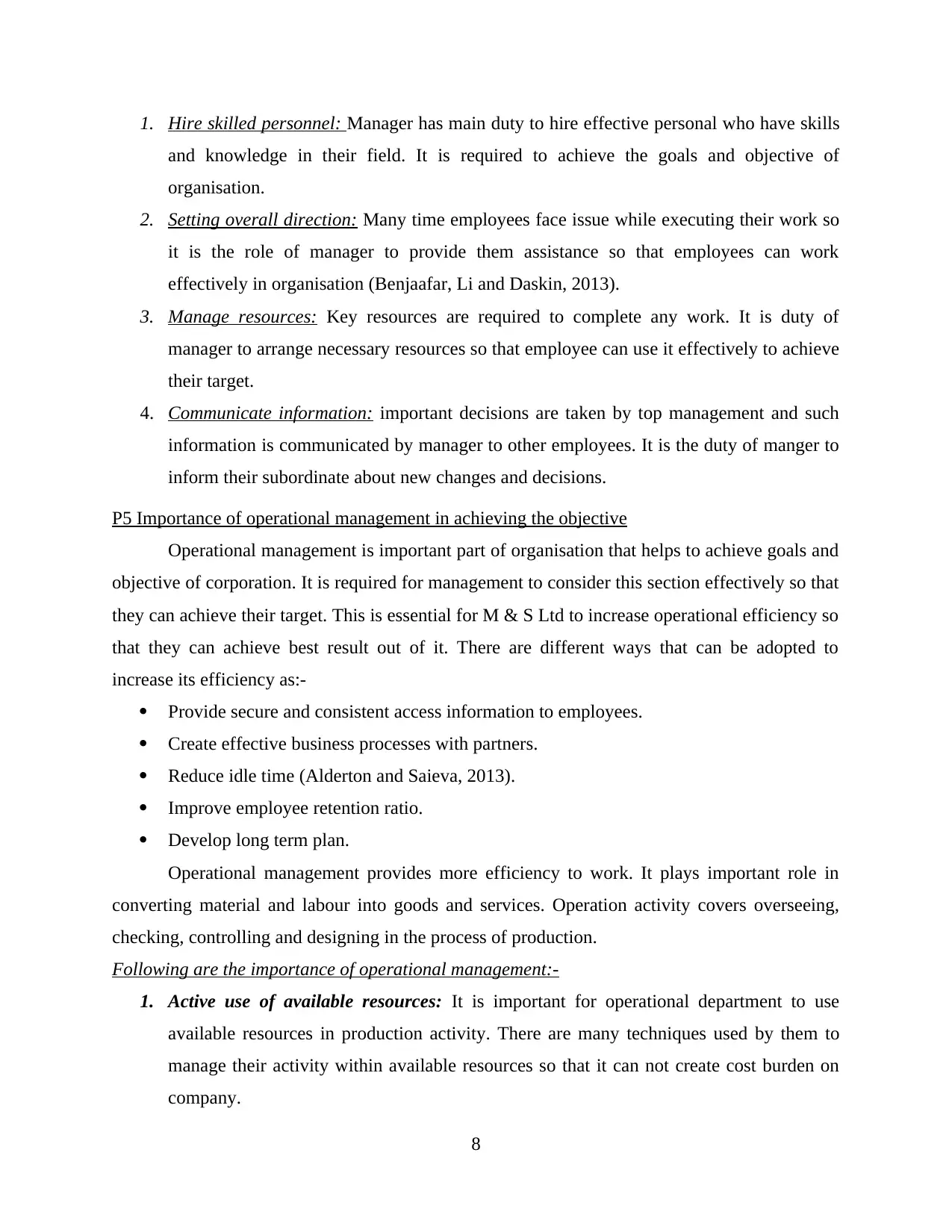
1. Hire skilled personnel: Manager has main duty to hire effective personal who have skills
and knowledge in their field. It is required to achieve the goals and objective of
organisation.
2. Setting overall direction: Many time employees face issue while executing their work so
it is the role of manager to provide them assistance so that employees can work
effectively in organisation (Benjaafar, Li and Daskin, 2013).
3. Manage resources: Key resources are required to complete any work. It is duty of
manager to arrange necessary resources so that employee can use it effectively to achieve
their target.
4. Communicate information: important decisions are taken by top management and such
information is communicated by manager to other employees. It is the duty of manger to
inform their subordinate about new changes and decisions.
P5 Importance of operational management in achieving the objective
Operational management is important part of organisation that helps to achieve goals and
objective of corporation. It is required for management to consider this section effectively so that
they can achieve their target. This is essential for M & S Ltd to increase operational efficiency so
that they can achieve best result out of it. There are different ways that can be adopted to
increase its efficiency as:-
Provide secure and consistent access information to employees.
Create effective business processes with partners.
Reduce idle time (Alderton and Saieva, 2013).
Improve employee retention ratio.
Develop long term plan.
Operational management provides more efficiency to work. It plays important role in
converting material and labour into goods and services. Operation activity covers overseeing,
checking, controlling and designing in the process of production.
Following are the importance of operational management:-
1. Active use of available resources: It is important for operational department to use
available resources in production activity. There are many techniques used by them to
manage their activity within available resources so that it can not create cost burden on
company.
8
and knowledge in their field. It is required to achieve the goals and objective of
organisation.
2. Setting overall direction: Many time employees face issue while executing their work so
it is the role of manager to provide them assistance so that employees can work
effectively in organisation (Benjaafar, Li and Daskin, 2013).
3. Manage resources: Key resources are required to complete any work. It is duty of
manager to arrange necessary resources so that employee can use it effectively to achieve
their target.
4. Communicate information: important decisions are taken by top management and such
information is communicated by manager to other employees. It is the duty of manger to
inform their subordinate about new changes and decisions.
P5 Importance of operational management in achieving the objective
Operational management is important part of organisation that helps to achieve goals and
objective of corporation. It is required for management to consider this section effectively so that
they can achieve their target. This is essential for M & S Ltd to increase operational efficiency so
that they can achieve best result out of it. There are different ways that can be adopted to
increase its efficiency as:-
Provide secure and consistent access information to employees.
Create effective business processes with partners.
Reduce idle time (Alderton and Saieva, 2013).
Improve employee retention ratio.
Develop long term plan.
Operational management provides more efficiency to work. It plays important role in
converting material and labour into goods and services. Operation activity covers overseeing,
checking, controlling and designing in the process of production.
Following are the importance of operational management:-
1. Active use of available resources: It is important for operational department to use
available resources in production activity. There are many techniques used by them to
manage their activity within available resources so that it can not create cost burden on
company.
8
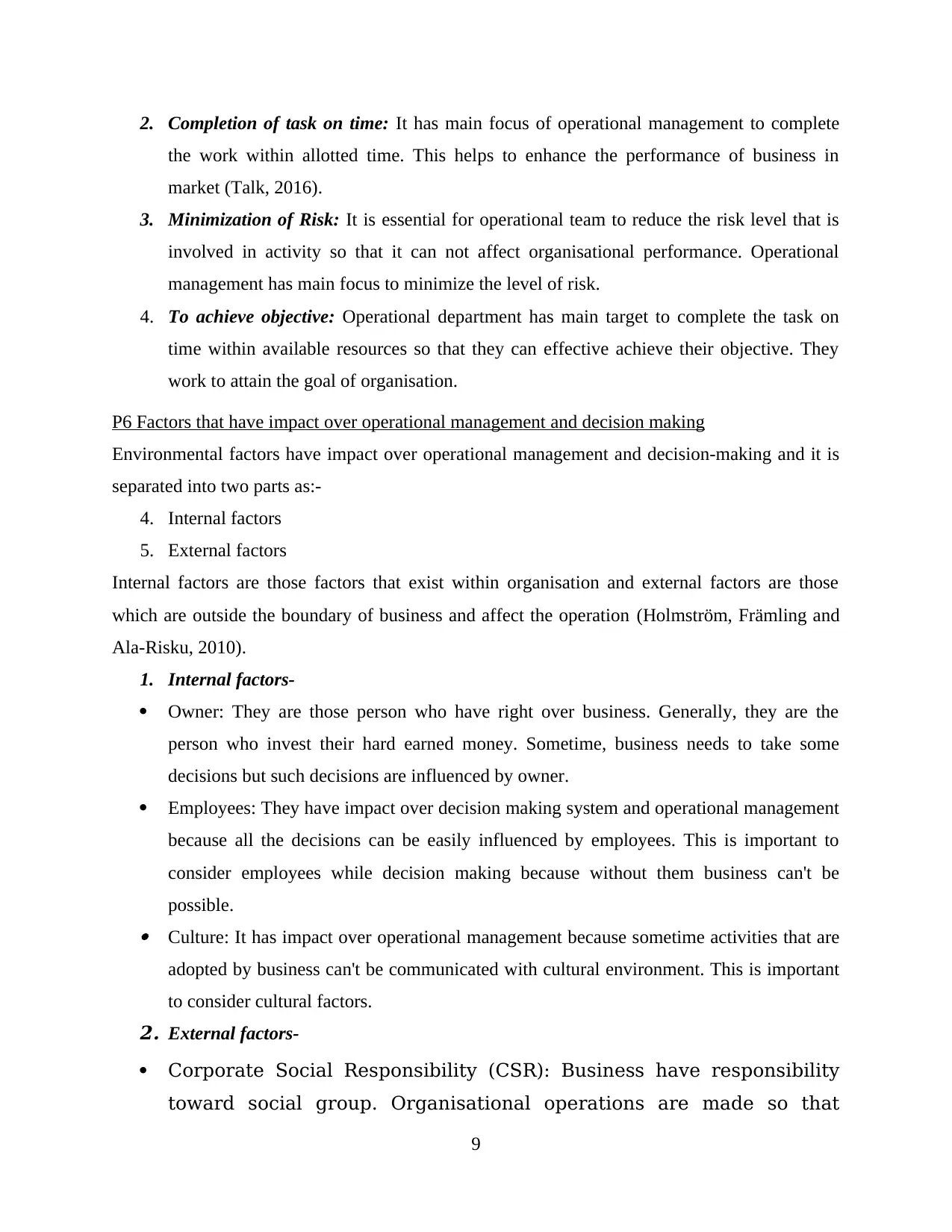
2. Completion of task on time: It has main focus of operational management to complete
the work within allotted time. This helps to enhance the performance of business in
market (Talk, 2016).
3. Minimization of Risk: It is essential for operational team to reduce the risk level that is
involved in activity so that it can not affect organisational performance. Operational
management has main focus to minimize the level of risk.
4. To achieve objective: Operational department has main target to complete the task on
time within available resources so that they can effective achieve their objective. They
work to attain the goal of organisation.
P6 Factors that have impact over operational management and decision making
Environmental factors have impact over operational management and decision-making and it is
separated into two parts as:-
4. Internal factors
5. External factors
Internal factors are those factors that exist within organisation and external factors are those
which are outside the boundary of business and affect the operation (Holmström, Främling and
Ala-Risku, 2010).
1. Internal factors-
Owner: They are those person who have right over business. Generally, they are the
person who invest their hard earned money. Sometime, business needs to take some
decisions but such decisions are influenced by owner.
Employees: They have impact over decision making system and operational management
because all the decisions can be easily influenced by employees. This is important to
consider employees while decision making because without them business can't be
possible. Culture: It has impact over operational management because sometime activities that are
adopted by business can't be communicated with cultural environment. This is important
to consider cultural factors.
2. External factors-
Corporate Social Responsibility (CSR): Business have responsibility
toward social group. Organisational operations are made so that
9
the work within allotted time. This helps to enhance the performance of business in
market (Talk, 2016).
3. Minimization of Risk: It is essential for operational team to reduce the risk level that is
involved in activity so that it can not affect organisational performance. Operational
management has main focus to minimize the level of risk.
4. To achieve objective: Operational department has main target to complete the task on
time within available resources so that they can effective achieve their objective. They
work to attain the goal of organisation.
P6 Factors that have impact over operational management and decision making
Environmental factors have impact over operational management and decision-making and it is
separated into two parts as:-
4. Internal factors
5. External factors
Internal factors are those factors that exist within organisation and external factors are those
which are outside the boundary of business and affect the operation (Holmström, Främling and
Ala-Risku, 2010).
1. Internal factors-
Owner: They are those person who have right over business. Generally, they are the
person who invest their hard earned money. Sometime, business needs to take some
decisions but such decisions are influenced by owner.
Employees: They have impact over decision making system and operational management
because all the decisions can be easily influenced by employees. This is important to
consider employees while decision making because without them business can't be
possible. Culture: It has impact over operational management because sometime activities that are
adopted by business can't be communicated with cultural environment. This is important
to consider cultural factors.
2. External factors-
Corporate Social Responsibility (CSR): Business have responsibility
toward social group. Organisational operations are made so that
9
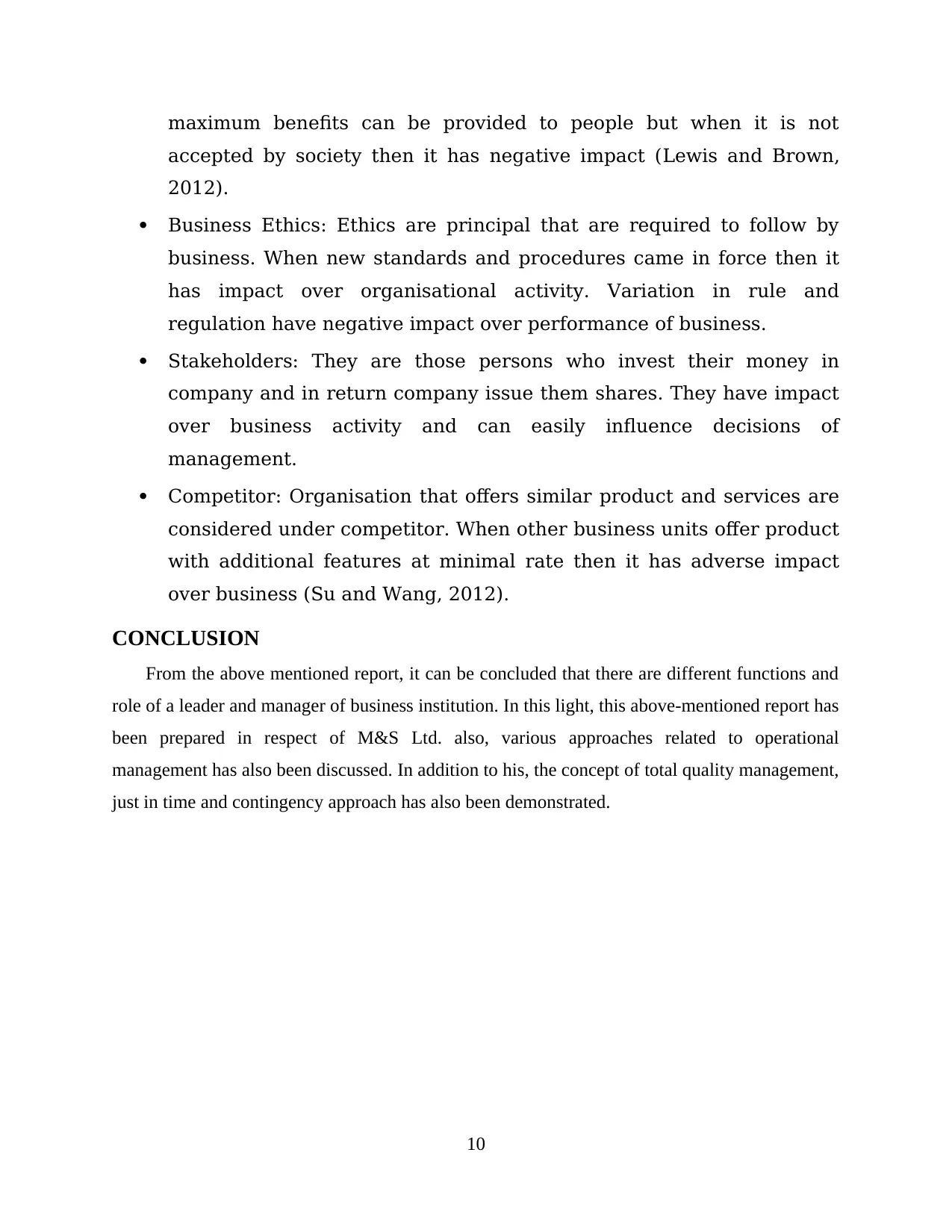
maximum benefits can be provided to people but when it is not
accepted by society then it has negative impact (Lewis and Brown,
2012).
Business Ethics: Ethics are principal that are required to follow by
business. When new standards and procedures came in force then it
has impact over organisational activity. Variation in rule and
regulation have negative impact over performance of business.
Stakeholders: They are those persons who invest their money in
company and in return company issue them shares. They have impact
over business activity and can easily influence decisions of
management.
Competitor: Organisation that offers similar product and services are
considered under competitor. When other business units offer product
with additional features at minimal rate then it has adverse impact
over business (Su and Wang, 2012).
CONCLUSION
From the above mentioned report, it can be concluded that there are different functions and
role of a leader and manager of business institution. In this light, this above-mentioned report has
been prepared in respect of M&S Ltd. also, various approaches related to operational
management has also been discussed. In addition to his, the concept of total quality management,
just in time and contingency approach has also been demonstrated.
10
accepted by society then it has negative impact (Lewis and Brown,
2012).
Business Ethics: Ethics are principal that are required to follow by
business. When new standards and procedures came in force then it
has impact over organisational activity. Variation in rule and
regulation have negative impact over performance of business.
Stakeholders: They are those persons who invest their money in
company and in return company issue them shares. They have impact
over business activity and can easily influence decisions of
management.
Competitor: Organisation that offers similar product and services are
considered under competitor. When other business units offer product
with additional features at minimal rate then it has adverse impact
over business (Su and Wang, 2012).
CONCLUSION
From the above mentioned report, it can be concluded that there are different functions and
role of a leader and manager of business institution. In this light, this above-mentioned report has
been prepared in respect of M&S Ltd. also, various approaches related to operational
management has also been discussed. In addition to his, the concept of total quality management,
just in time and contingency approach has also been demonstrated.
10
Paraphrase This Document
Need a fresh take? Get an instant paraphrase of this document with our AI Paraphraser
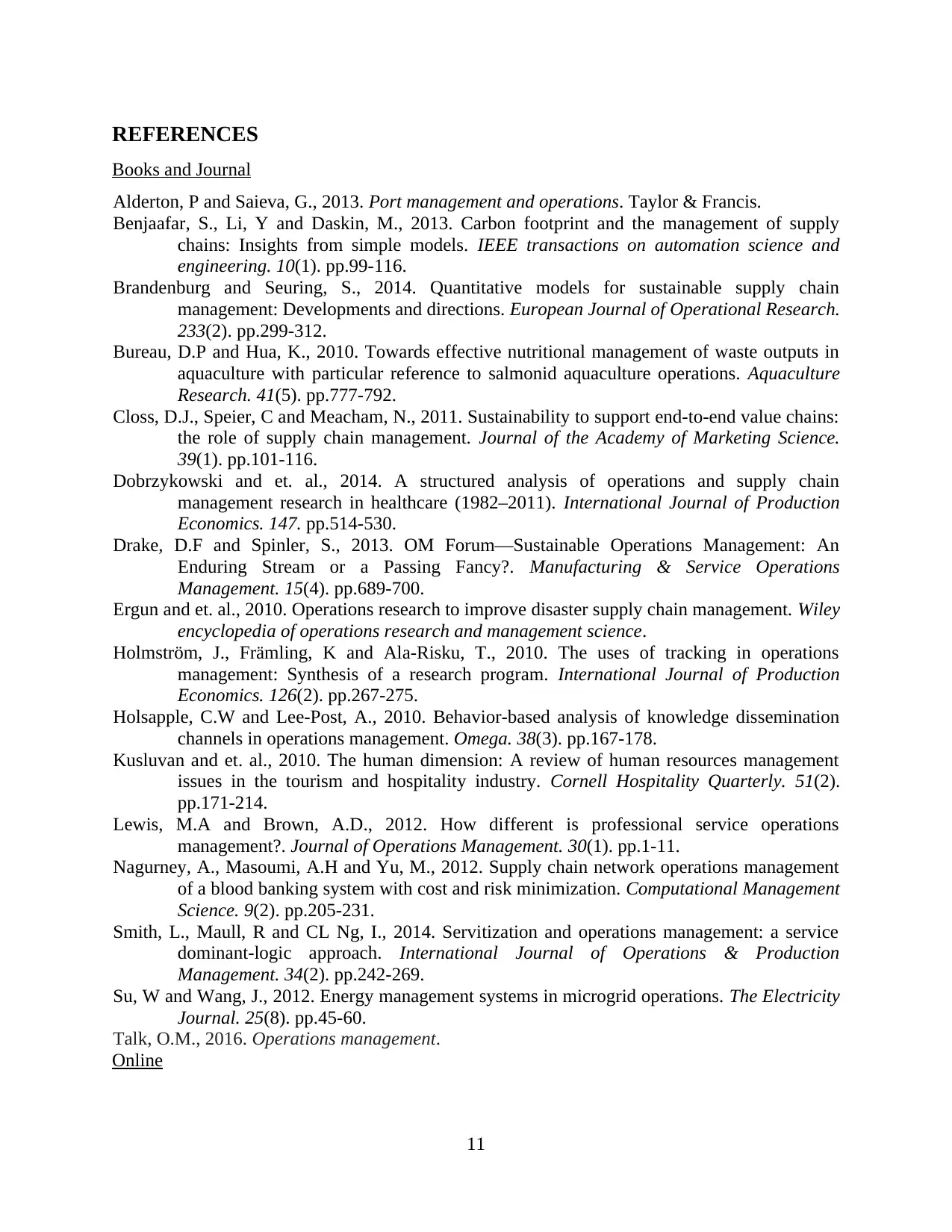
REFERENCES
Books and Journal
Alderton, P and Saieva, G., 2013. Port management and operations. Taylor & Francis.
Benjaafar, S., Li, Y and Daskin, M., 2013. Carbon footprint and the management of supply
chains: Insights from simple models. IEEE transactions on automation science and
engineering. 10(1). pp.99-116.
Brandenburg and Seuring, S., 2014. Quantitative models for sustainable supply chain
management: Developments and directions. European Journal of Operational Research.
233(2). pp.299-312.
Bureau, D.P and Hua, K., 2010. Towards effective nutritional management of waste outputs in
aquaculture with particular reference to salmonid aquaculture operations. Aquaculture
Research. 41(5). pp.777-792.
Closs, D.J., Speier, C and Meacham, N., 2011. Sustainability to support end-to-end value chains:
the role of supply chain management. Journal of the Academy of Marketing Science.
39(1). pp.101-116.
Dobrzykowski and et. al., 2014. A structured analysis of operations and supply chain
management research in healthcare (1982–2011). International Journal of Production
Economics. 147. pp.514-530.
Drake, D.F and Spinler, S., 2013. OM Forum—Sustainable Operations Management: An
Enduring Stream or a Passing Fancy?. Manufacturing & Service Operations
Management. 15(4). pp.689-700.
Ergun and et. al., 2010. Operations research to improve disaster supply chain management. Wiley
encyclopedia of operations research and management science.
Holmström, J., Främling, K and Ala-Risku, T., 2010. The uses of tracking in operations
management: Synthesis of a research program. International Journal of Production
Economics. 126(2). pp.267-275.
Holsapple, C.W and Lee-Post, A., 2010. Behavior-based analysis of knowledge dissemination
channels in operations management. Omega. 38(3). pp.167-178.
Kusluvan and et. al., 2010. The human dimension: A review of human resources management
issues in the tourism and hospitality industry. Cornell Hospitality Quarterly. 51(2).
pp.171-214.
Lewis, M.A and Brown, A.D., 2012. How different is professional service operations
management?. Journal of Operations Management. 30(1). pp.1-11.
Nagurney, A., Masoumi, A.H and Yu, M., 2012. Supply chain network operations management
of a blood banking system with cost and risk minimization. Computational Management
Science. 9(2). pp.205-231.
Smith, L., Maull, R and CL Ng, I., 2014. Servitization and operations management: a service
dominant-logic approach. International Journal of Operations & Production
Management. 34(2). pp.242-269.
Su, W and Wang, J., 2012. Energy management systems in microgrid operations. The Electricity
Journal. 25(8). pp.45-60.
Talk, O.M., 2016. Operations management.
Online
11
Books and Journal
Alderton, P and Saieva, G., 2013. Port management and operations. Taylor & Francis.
Benjaafar, S., Li, Y and Daskin, M., 2013. Carbon footprint and the management of supply
chains: Insights from simple models. IEEE transactions on automation science and
engineering. 10(1). pp.99-116.
Brandenburg and Seuring, S., 2014. Quantitative models for sustainable supply chain
management: Developments and directions. European Journal of Operational Research.
233(2). pp.299-312.
Bureau, D.P and Hua, K., 2010. Towards effective nutritional management of waste outputs in
aquaculture with particular reference to salmonid aquaculture operations. Aquaculture
Research. 41(5). pp.777-792.
Closs, D.J., Speier, C and Meacham, N., 2011. Sustainability to support end-to-end value chains:
the role of supply chain management. Journal of the Academy of Marketing Science.
39(1). pp.101-116.
Dobrzykowski and et. al., 2014. A structured analysis of operations and supply chain
management research in healthcare (1982–2011). International Journal of Production
Economics. 147. pp.514-530.
Drake, D.F and Spinler, S., 2013. OM Forum—Sustainable Operations Management: An
Enduring Stream or a Passing Fancy?. Manufacturing & Service Operations
Management. 15(4). pp.689-700.
Ergun and et. al., 2010. Operations research to improve disaster supply chain management. Wiley
encyclopedia of operations research and management science.
Holmström, J., Främling, K and Ala-Risku, T., 2010. The uses of tracking in operations
management: Synthesis of a research program. International Journal of Production
Economics. 126(2). pp.267-275.
Holsapple, C.W and Lee-Post, A., 2010. Behavior-based analysis of knowledge dissemination
channels in operations management. Omega. 38(3). pp.167-178.
Kusluvan and et. al., 2010. The human dimension: A review of human resources management
issues in the tourism and hospitality industry. Cornell Hospitality Quarterly. 51(2).
pp.171-214.
Lewis, M.A and Brown, A.D., 2012. How different is professional service operations
management?. Journal of Operations Management. 30(1). pp.1-11.
Nagurney, A., Masoumi, A.H and Yu, M., 2012. Supply chain network operations management
of a blood banking system with cost and risk minimization. Computational Management
Science. 9(2). pp.205-231.
Smith, L., Maull, R and CL Ng, I., 2014. Servitization and operations management: a service
dominant-logic approach. International Journal of Operations & Production
Management. 34(2). pp.242-269.
Su, W and Wang, J., 2012. Energy management systems in microgrid operations. The Electricity
Journal. 25(8). pp.45-60.
Talk, O.M., 2016. Operations management.
Online
11
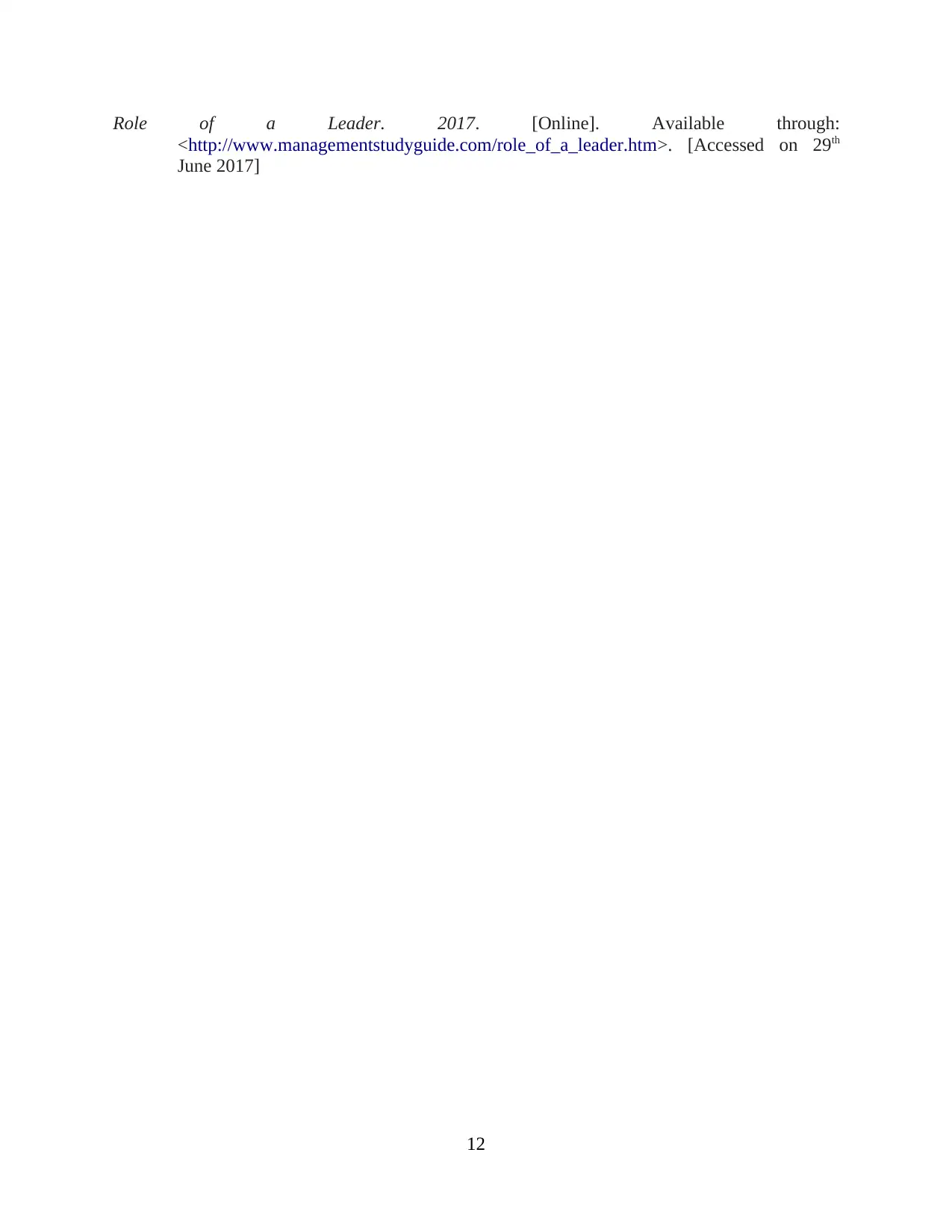
Role of a Leader. 2017. [Online]. Available through:
<http://www.managementstudyguide.com/role_of_a_leader.htm>. [Accessed on 29th
June 2017]
12
<http://www.managementstudyguide.com/role_of_a_leader.htm>. [Accessed on 29th
June 2017]
12
1 out of 15
Related Documents
Your All-in-One AI-Powered Toolkit for Academic Success.
+13062052269
info@desklib.com
Available 24*7 on WhatsApp / Email
![[object Object]](/_next/static/media/star-bottom.7253800d.svg)
Unlock your academic potential
© 2024 | Zucol Services PVT LTD | All rights reserved.





